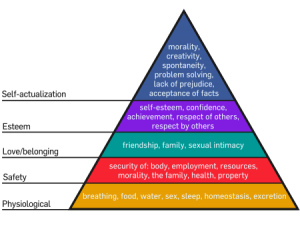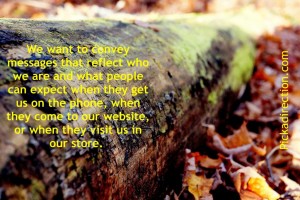The entire purpose of social media is to connect with others, plain and simple. Connection (outside of social media) happens when we talk with others and share experiences. Connection is a meaningful thing, it’s the 2nd and 3rd most important in Maslow’s Hierarchy after our basic survival needs. Translated, this means connection isn’t just being someone’s friend on Facebook or following someone in Tumblr. Social media connections are made when we talk with people (not at them), when we feel a sense of community, and when others care about what we have to offer. Connection doesn’t happen just because we live in the same city or occasionally go to the same party.
We now have to figure out how to connect with people on these social media platforms. In Part 1 of Social Strategery we talked about being everywhere so we could be found at any party if someone were to look for us. Then in Part 2 we talked about picking one or two platforms that will have the largest demographic of our customer base and preparing to focus our efforts on those platforms. In Part 3 we’ll discuss how to make those connections on our hand-picked platforms. In Part 4 (tomorrow) we will talk about how to distribute information to the other accounts that we have setup we are not focusing on.
Communication
Communication is a two way street: talking AND listening. The most effective social media campaigns listen more than they talk. A common mistake that many businesses make is to just post on Facebook when they want something. We post when we have a new product, or we post when reduce a price, or we post when we want to same something from people. We need to post when we have something that will bring value to our customers, not just when we want something from them.
Here are some of the worst practices on social media that many businesses have in common:
- they do more talking then listening, and some don’t listen at all
- they only post things that are beneficial to them
- they don’t have authentic personality in their posts
- they aren’t clear with their messages
Here’s now we can avoid those mistakes and build effective social media campaigns by listening, engaging, and then asking.
Listen
Think about the guy that always talks and you can never get a word in. How did he get invited to this party? Does anyone like him? Does anyone ask his opinion? We don’t have to because he usually offers it without being prompted. This is how we are perceived when all we do is post on social media without engaging. It’s a self-serving approach that would be scoffed at if we changed the setting to a party. I call this ‘shouting.’ Telling people to “Look at me, I’m the greatest!” without bringing value the people we’re trying to convert to customers.
If we watch our timelines we will find out what people want and we can offer something to them if we’re attentive. We can see what is popular online and craft our messages to resonate with the people that follow us. When we cater our messages to our audience we are much more likely to get them engaged with us. I use the below tools to monitor what is going on in the world. Set these up and have them sent to your inbox once a day/week so you can find out what is going on outside of your immediate circles.
Another way to listen is to ask for feedback on our social media accounts. Ask followers what product improvements they could use, ask them what new services they would like us to offer, ask what they don’t like about our business, ask what they had for lunch today. Just ask! And when people give us honest feedback, we need to respond honestly to them. Even if we’re not face to face, people’s noses still work. BS is easy to smell.
Engage
One way Epic Day Outdoors has engaged with users on Instagram is by finding pictures that are relevant to our niche and commenting on them. If we find a great fishing photo we tell them congrats, if we find a great surfing video we compliment them on their wave and ask where the video was taken, and if we see funny hashtag on a rock climbing picture we make a relevant joke and ask tell them it looks like a fun day.
We like as many photos as possible and we do our best to comment on the ones that aren’t quite “like-worthy” so that our outreach is even larger.We follow the people we engage with and do our best to flatter them when we initially follow them. We are giving as much as much as possible so when it’s time to ask, people are more open to give back. If all we did was post photos and follow people, we wouldn’t have a very engaged user base and our social campaign wouldn’t be very effective.
Beneficial
So we know what NOT to do; don’t shout at people, it’s rude. When engaging, remember the party analogy, we want to provide value to the people we’re talking to. Value can be funny posts, value can be telling someone they have a nice cover photo, value can even be sending people to your site using content marketing (free info) that could be useful to them. Value is not what we sell.
People need to know who we are and know that we provide value of some sort or they will tune out our noise. We can also provide value by offering helpful tips, free user guides, or even interesting articles that pertain to our business. The most effective social media campaigns will provide beneficial, authentic information that is relevant to what is happening right now in the world by keeping an eye on trends with the tools above. This does not have to come from us, it can come from other sources as long as it’s relevant and trusted. When we post things that we didn’t create, our credibility is on the line.
Authentic
When we mix the personality of our business with our valuable posts we are moving in the right direction. We want to convey messages that reflect who we are and what people can expect when they get us on the phone, when they come to our website, or when they visit us in our store. People should not be able to tell the difference from social media messages to in-store conversations.
It’s important for a brand to have an authentic voice or else we can become lost in the noisy world of social media. Think, what makes us unique? Why should people be our customers instead of our competitors? When we answer those questions, infuse our social media messages with those answers to get our authentic voice.
Asking
To avoid ‘shouting’ we need to be transparent about when it’s time to ask for the sale. This means we don’t try and trick people into clicking a link or signing up, we tell them up front what they’re getting. On sales calls, we don’t just walk up to someone and ask if they want to buy. We take time to build rapport, we make connections, we ask questions about their business/life, and then when the time is right we go for the close.
We have to engage before we close or the sales process will never work. If we change the setting, we see how redundant our efforts can be on social media. So now that we’ve provided value more than we’ve asked for business, we can be clear about what we’re asking for. The best sales people are not sneaky, they are not liars, and they are good communicators. Now we have a voice, we have attention of our users, and have the opportunity to ask for the sale. We have set ourselves up for success, just ask the question, “Will you buy my product?”
Thus far in Social Strategery we have covered how to be everywhere on social media, how to pick the right platform for our business, and now we know how to communicate effectively on our hand-picked platforms of choice. In Part 4 we’ll explore how to maintain a presence on other platforms that we do not use as often as our hand-picked accounts.
—
How do you engage with your followers?
Connect with me on Twitter, I’d love to hear your successes (& failures) on the subject.
P.S. 14 Days till Christmas!


[…] work inspires passion. It fulfills our hierarchical need to be challenged. Difficult tasks often require us to be creative in our efforts. If our best […]